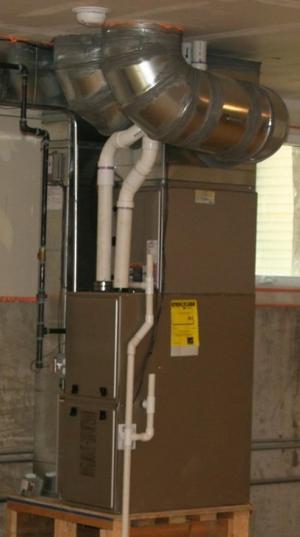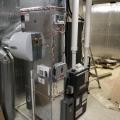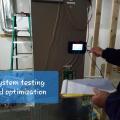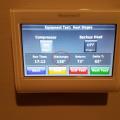Scope
Upgrade an existing heating, ventilation and air conditioning (HVAC) system for expansion, efficiency, or comfort with one or more of the following measures.
- Replace a PSC fan motor with an ECM drive.
- Replace burners in oil furnaces or boilers.
- Upgrade to a programmable thermostat.
- Add dehumidification.
- Improve filtration.
- Improve source-exhaust fans (i.e., bath or kitchen exhaust fans).
- Add whole-house mechanical ventilation.
- Seal and/or insulate the duct system.
- Improve supply air coverage and balancing capability.
- Add ductwork to extend space conditioning to added living space.
- Add terminal units (e.g., radiator/convector, or additional ductless head) to extend space conditioning to added living space.
- Add a dedicated system to independently heat or cool a new addition.
Prior to undertaking an upgrade or expansion:
- Assess the need for replacing or upgrading the HVAC system. See the guide Pre-Retrofit Assessment of Existing HVAC Systems.
- Examine the HVAC equipment and distribution system to determine the scope, capacity, and capabilities of the existing system.
- Confirm that the existing system has adequate remaining useful life to warrant the effort and expense of an upgrade.
- Confirm the compatibility of the upgrade with the existing system, including power and airflow requirements.
- Complete inexpensive and easy fixes before investing in costly upgrades.
- Repair non-functioning items and clean dirty components prior to beginning the upgrade.
- Remove old construction debris and clear a safe and convenient working/staging area.
- Collect all necessary tools and supplies prior to beginning work.
- Provide an adequate light source.
- Turn off all switched equipment and power down all equipment at the breaker box (except as needed for equipment testing with a multi-meter, etc.).
NOTE: If combustion appliances are upgraded or replaced or if other energy-efficiency upgrades are made to a home with combustion appliances, review the guide Pre-Retrofit Assessment of Combustion Appliances to ensure safe conditions currently exist and to avoid introducing unsafe conditions.
For more information, view the U.S. Department of Energy’s Standard Work Specifications regarding HVAC system upgrades.
See the Compliance Tab for links to related codes and standards and voluntary federal energy-efficiency program requirements.
Description
When it comes to getting optimal performance from an older home’s HVAC equipment, improvements span the spectrum from maintenance and tuneups to total system replacement. In between are several other steps homeowners and contractors can take to improve and extend the performance of the home’s existing systems. Below are several options to consider.
Decision Making
Carefully consider if upgrading an existing HVAC system is the appropriate choice. In many cases the costs associated with intervention beyond basic maintenance and cleaning do not reap adequate benefits compared to replacing the system with new equipment because new equipment often has higher efficiency and better performance.
For general assessment and decision-making, including useful decision trees for determining whether or not to replace an existing system, see the guide Pre-Retrofit Assessment of Existing HVAC Systems. For general information regarding HVAC system types, typical efficiencies, and capabilities, see Building America Best Practices Series Volume 14 - HVAC: A Guide for Contractors to Share with Homeowners. You can also search the Building America Solution Center for guides describing specific heating and cooling systems.
Maintenance and Repair
For general maintenance and repair, see the following resources:
Upgrades
In addition to general maintenance, there are several specific HVAC upgrades that can improve system performance, extend system life, or expand service. The upgrades below were included on this list because they were either deemed cost-effective due to energy savings, or reasonable interventions to improve or expand system capability, or necessary because of lifestyle or architectural changes. Each of these measures is further addressed in the guides linked here.
- Replace a PSC fan motor with an ECM drive - for energy savings and quiet variable-speed continuous operation for greater comfort. For more information, see the guide ECM Air Handler Fans.
- Replace burners in oil furnaces or boilers with a high-efficiency flame-retention-head oil burner for significant energy savings. For more information, see the guide Oil-Fired Boilers.
- Upgrade to a programmable thermostat – to automatically set back temperatures while away from home for energy savings. For more information, see the guide Thermostat Control.
- Add dehumidification – to control indoor humidity levels for improved comfort and to inhibit mold growth. For more information, see the guide Whole-House Dehumidification.
- Improve filtration by adding a high-MERV filter for improved indoor air quality. For more information, see the guides High-MERV Filter and Proper Installation of Furnace and Air-Handler Filters.
- Improve exhaust fans by adding a backdraft damper to prevent heat loss. For more information, see the guide Bathroom Exhaust Fans.
- Add whole-house mechanical ventilation to improve building air quality. For more information, see the guides Whole-Building Delivered Ventilation and Whole-House Ventilation Strategies for Existing Homes.
- Seal and/or insulate the duct system to improve the performance of your HVAC system, increase comfort, and reduce energy costs. For more information see the guides Sealed and Insulated Flex Ducts, Sealed and Insulated Metal Ducts, Sealed and Insulated Fiber Board Ducts, and Injected Spray Sealant for Existing Ducts.
- Improve balancing of ducted systems to improve energy savings and thermal control by confirming an adequate return path, resizing return grilles, or adding transfer grilles or jump ducts, or adding dampers in the supply or return ducts. For more information, see the guides Ducted Returns, Transfer Grilles, Jump Ducts, Pressure Balancing Supply and Return Ducts in Existing Homes.
- Add ductwork to extend space conditioning to added living space. For more information see the guide Compact Air Distribution.
- Add terminal units (e.g., a radiator/convector or additional ductless heat pump head) to extend space conditioning to added living space. For more information see the guides Mini-Split (Ductless) Heat Pumps, Gas-Fired Boilers, Oil-Fired Boilers, and Condensing Boilers.
- Add a dedicated system to independently heat or cool a new addition. For more information see the guide Mini-Split (Ductless) Heat Pumps.
Costs
The upgrades listed above vary widely in terms of costs and labor involved in installation. If you are considering equipment replacement instead, while replacing HVAC equipment can be costly and labor-intensive, it often reaps large rewards in terms of energy cost savings and comfort.
Some upgrades that reduce energy use may qualify for local or federal rebates. Check for rebates and incentives on local utility websites and also at the following database:
Database of State Incentives for Renewables & Efficiency (DSIRE).
Climate
No climate-specific information applies.
Training
Compliance
Compliance
Check with the Authority Having Jurisdiction to determine if upgrade or expansion to existing Heating Ventilation Air Conditioning (HVAC) equipment requires compliance with current codes.
Air Conditioning Contractors of America (ACCA) Standards
ACCA Manual S - Residential Equipment Selection
ACCA Manual D - Residential Duct Systems
More
More Info.
Access to some references may require purchase from the publisher. While we continually update our database, links may have changed since posting. Please contact our webmaster if you find broken links.
Sales
High-Efficiency HVAC Equipment = High-Efficiency or Ultra-Efficient Comfort Equipment
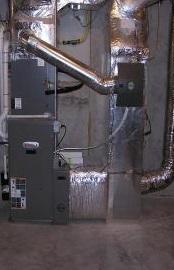
Because heating and cooling costs are the largest contributors to utility bills, inefficient comfort equipment creates significant costs for homeowners. Not installing high- or ultra-efficient comfort equipment is a missed opportunity, especially if the proper steps have been taken to insulate and air seal a home. High-efficiency comfort equipment meets ENERGY STAR requirements for efficiency. Ultra-efficient comfort equipment meets or exceeds the criteria for ENERGY STAR’s “Most Efficient” designation, indicating it is among the most efficient heating and cooling products available on the market.
